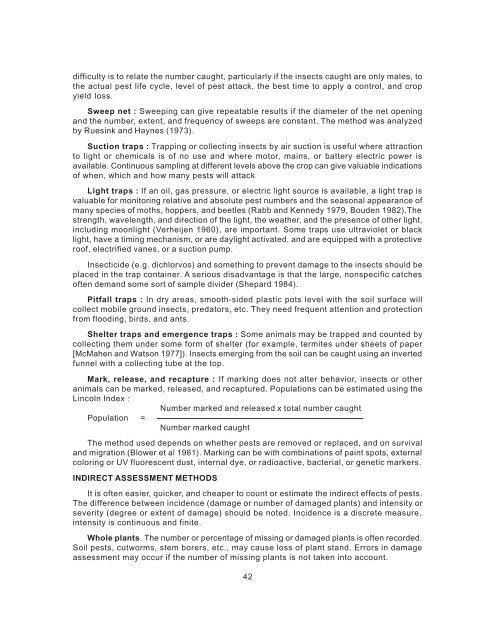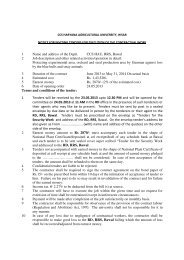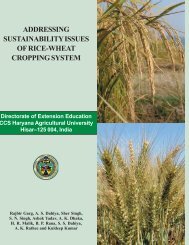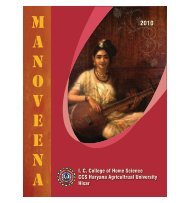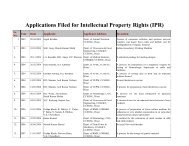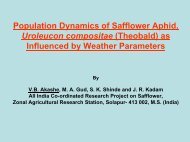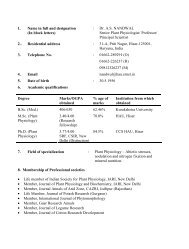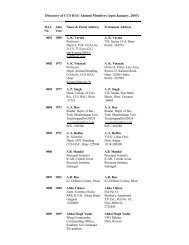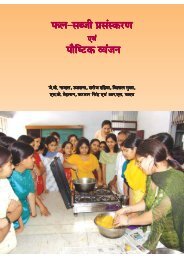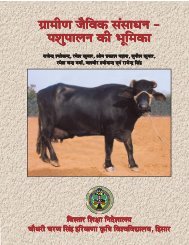Foreword - CCS HAU, Hisar
Foreword - CCS HAU, Hisar
Foreword - CCS HAU, Hisar
Create successful ePaper yourself
Turn your PDF publications into a flip-book with our unique Google optimized e-Paper software.
difficulty is to relate the number caught, particularly if the insects caught are only males, to<br />
the actual pest life cycle, level of pest attack, the best time to apply a control, and crop<br />
yield loss.<br />
Sweep net : Sweeping can give repeatable results if the diameter of the net opening<br />
and the number, extent, and frequency of sweeps are constant. The method was analyzed<br />
by Ruesink and Haynes (1973).<br />
Suction traps : Trapping or collecting insects by air suction is useful where attraction<br />
to light or chemicals is of no use and where motor, mains, or battery electric power is<br />
available. Continuous sampling at different levels above the crop can give valuable indications<br />
of when, which and how many pests will attack<br />
Light traps : If an oil, gas pressure, or electric light source is available, a light trap is<br />
valuable for monitoring relative and absolute pest numbers and the seasonal appearance of<br />
many species of moths, hoppers, and beetles (Rabb and Kennedy 1979, Bouden 1982).The<br />
strength, wavelength, and direction of the light, the weather, and the presence of other light,<br />
including moonlight (Verheijen 1960), are important. Some traps use ultraviolet or black<br />
light, have a timing mechanism, or are daylight activated, and are equipped with a protective<br />
roof, electrified vanes, or a suction pump.<br />
Insecticide (e.g. dichlorvos) and something to prevent damage to the insects should be<br />
placed in the trap container. A serious disadvantage is that the large, nonspecific catches<br />
often demand some sort of sample divider (Shepard 1984).<br />
Pitfall traps : In dry areas, smooth-sided plastic pots level with the soil surface will<br />
collect mobile ground insects, predators, etc. They need frequent attention and protection<br />
from flooding, birds, and ants.<br />
Shelter traps and emergence traps : Some animals may be trapped and counted by<br />
collecting them under some form of shelter (for example, termites under sheets of paper<br />
[McMahen and Watson 1977]). Insects emerging from the soil can be caught using an inverted<br />
funnel with a collecting tube at the top.<br />
Mark, release, and recapture : If marking does not alter behavior, insects or other<br />
animals can be marked, released, and recaptured. Populations can be estimated using the<br />
Lincoln Index :<br />
Number marked and released x total number caught<br />
Population =<br />
Number marked caught<br />
The method used depends on whether pests are removed or replaced, and on survival<br />
and migration (Blower et al 1981). Marking can be with combinations of paint spots, external<br />
coloring or UV fluorescent dust, internal dye, or radioactive, bacterial, or genetic markers.<br />
INDIRECT ASSESSMENT METHODS<br />
It is often easier, quicker, and cheaper to count or estimate the indirect effects of pests.<br />
The difference between incidence (damage or number of damaged plants) and intensity or<br />
severity (degree or extent of damage) should be noted. Incidence is a discrete measure,<br />
intensity is continuous and finite.<br />
Whole plants. The number or percentage of missing or damaged plants is often recorded.<br />
Soil pests, cutworms, stem borers, etc., may cause loss of plant stand. Errors in damage<br />
assessment may occur if the number of missing plants is not taken into account.<br />
42


